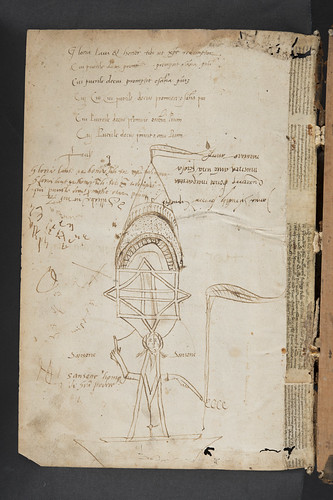Hieronymus, S.: Epistolae.
Add: Lupus de Oliveto (Olmeto): Regula monachorum ex Epistolis Hieronymi excerpta.
[Venice: Doninus Pincius, not before 1502]
Fol. π6 a-u8 x4 A-Z8 AA-CC8 DD6 EE8 FF6. [6], ‘390’ [i.e. 392] leaves (323-324 repeated; 25, 71, 96, 139, 163, 186, 240, 298, 316, 366, 390 misnumbered 52, 72, 69, 136, 263, 189, 220, 898, 315, 266, and 90).
The second and third leaves of the preliminary quire are numbered but not signed.
ISTC ih00177000; GW XI S.56a; Goff H177; Polain(B) 4436; BSB-Ink H-256; Walsh S1-2751a.
Type-assignment to Doninus Pincius by GW (Goff).
Dated [1496] and ascribed to Philippus Pincius in IGI 4744. The date 7 Jan. 1496 appears in the first colophon and is presumably reproduced from the edition Venice: Johannes Rubeus Vercellensis, 7 Jan. 1496 and 12 July 1496 (Goff H175) - ISTC. Dated [not before 1502] in ISTC.
The Regula monachorum is elsewhere found as an anonymous work entitled Aureola ex floribus S. Hieronymi contexta (B. Lambert, Bibliotheca Hieronymiana manuscripta, IIIb (Steenbrugis: 1970) no. 552).
| GIP number: | H20 |
| Shelf-mark: | Sp Coll K.T. f2 (see main library entry for this item) |
| Provenance: | Constantin von Tischendorf (1815-1874), biblical scholar: his library of over 1,000 volumes purchased after his death for the Free Church College Library, Glasgow. Free Church College Library, Glasgow (later Trinity College Library), founded 1856: Trinity College Library shelfmark “42/1” in pencil on inner front board. University of Glasgow: Trinity College Library placed on permanent deposit in University of Glasgow Library in 1974 by the General Assembly of the Church of Scotland. |
| Binding: | 16th-century wooden boards, quarter calf decorated with fillets and rope-work tooling (cf. Weale, Bookbindings, fig. 13 (lower left), p. xviii); evidence of parchment manuscript spine strengtheners; evidence of two fore-edge clasps and a single clasp on the upper and on the lower edges of the boards (all clasping onto front board and all now lost); the outer surface of the front board is lightly incised with a circular design with what appears to be an abbreviated inscription at its circumference (“... M.O.V.S.S.”); title written in ink on front board; without pastedowns. Size: 327 x 215 mm. |
| Leaf size: | 311 x 211 mm. |
| Annotations: | Occasional marginal annotations and nota marks in a 16th-century hand. Various quotations in a 16th-century hand on recto of first front flyleaf “Semel in anno risit Apollo”, “No[n] o[mn]ia possumus o[mn]es” (Virgil, Eclogues, 8:63), “Qui se exaltat humiliabitur et qui se humiliat, exalbitur” (Luke 14:11), “alter alterius onera portate” (Galatians 6:2), and an annotation “Constantinopolitanissimor[um] Tetragramaton Iesus saluator Ierosolomitaminorum”; on the same page is a scored-through list of nineteen north-Italian names (e.g. “Iacomo d[i] Suald mulinor da Valisella”) dated “adi 4 fevrar 1526”. Quotation “Res age q[ua]e prosu[nt]” (Cato, Disticha 4:7) on verso of first front flyleaf. Annotations on recto of second front flyleaf “Constantinopolitanissimorum Ierosolomitanorum Magnificentissimorum cardinalium honorabilissimorum Patificentissimorum Quam difficillimu[m] est [...] salvarj ...” and a quotation from Ovid, Heroides 7:191 “Anna sorror, sorror Anna me[a]e mala co[n]scia culp[a]e”. Eight-line inscription on verso of second front flyleaf beginning “Thaema nostru[m] hodiernu[m] quod filiólo tuo dedimus ...”. Numerous annotations and quotations on the recto of the first rear flyleaf including “Virginis intactae du[m] veneris ante figura[m] p[ret]ereundo caue ne siliat[ur] aue”, “Publicani publicauerunt pupillis populorum”, “Verba liga[n]t homines, et funes cornua bouum”, “Chi in ogno loco saciar uuol sua uuolgia ... a lultimo se spolgia”, “Facilis descensus auerni sed reuocare gradu[m] supperasq[ue] euadere ad auras, hoc opus hic labor est. Paucj quos aequus amauit iupiter aut ardens euexit ad haetera uirtus” (Virgil, Aeneid, 6:126-30). Sayings and phrases in Italian on verso of first rear flyleaf and on recto of second rear flyleaf, including “meroda imboca a Chiota leota” and “meroda inbaroba a Chyota scriota”. On verso of second rear flyleaf are various annotations, including a prayer “Gloria laus & honor tibi sit [Christ]e redemptor cui puerile decus prompsit osan[n]a piu[m]” and a quotation “Quaerentj bonas margaritas inuenta aute[m] una p[re]ciosa” (Matthew 13:45-6). Written directly onto the inner front board is musical notation and the beginning of the Lent hymn “Audi benigne condito[r] no[str]as preces cum fletib[us] in hoc sacro ieiunio”, together with a few mathematical calculations. |
| Decoration: | Pen-and-ink drawing on second rear flyleaf of Samson bringing down the Temple with caption in Italian “sansone homo di gra[n] podere ecce”; pen-and-ink drawing made directly onto the inner surface of the rear board of a galloping horse, saddled and harnessed but without a rider; pen-and ink drawing on inner front board of a head-piece or crown. |
| Imperfections: | Wanting M2-7, S4.5, BB8. |





